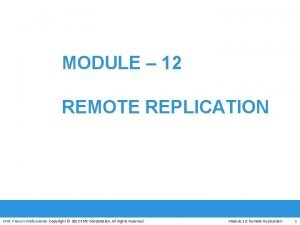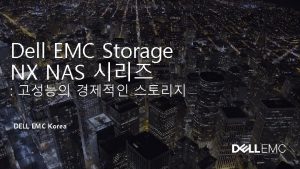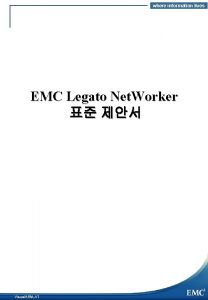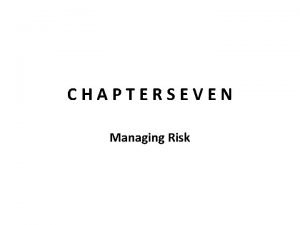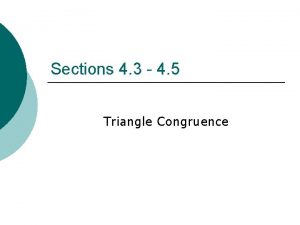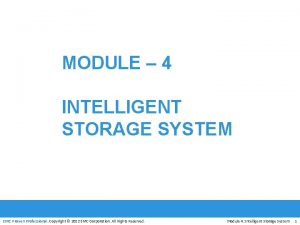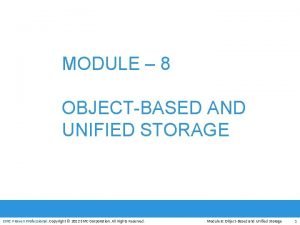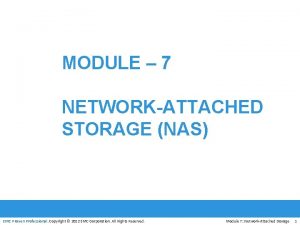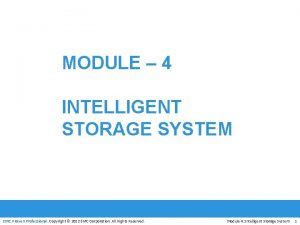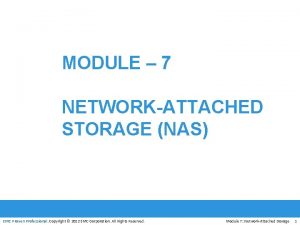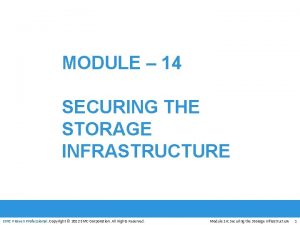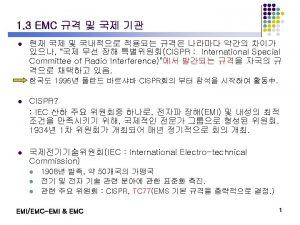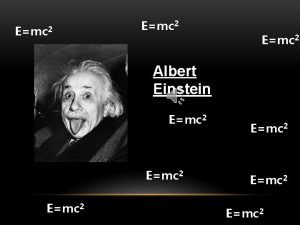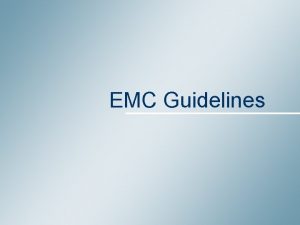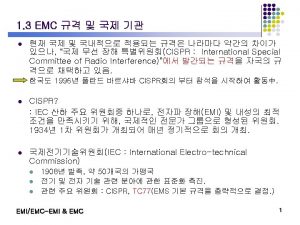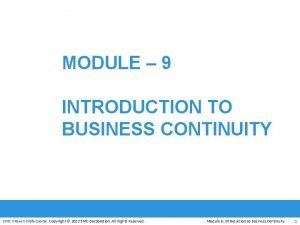MODULE 1 INTRODUCTION TO INFORMATION STORAGE EMC Proven















- Slides: 15

MODULE – 1 INTRODUCTION TO INFORMATION STORAGE EMC Proven Professional. Copyright © 2012 EMC Corporation. All Rights Reserved. Module 1: Introduction to Information Storage 1

Module 1: Introduction to Information Storage Upon completion of this module, you should be able to: • Define data and information • Describe types of data • Describe the evolution of storage architecture • Describe the core elements of a data center • List the key characteristics of data center • Provide an overview of virtualization and cloud computing EMC Proven Professional. Copyright © 2012 EMC Corporation. All Rights Reserved. Module 1: Introduction to Information Storage 2

Why Information Storage and Management? • Information is the knowledge derived from data • Growth of digital information has resulted in information • explosion We live in an on-command, on-demand world 4 We need information when and where required • Increasing dependency on fast and reliable access to information • Businesses seek to store, protect, optimize, and leverage the information 4 To gain competitive advantage 4 To derive new business opportunity EMC Proven Professional. Copyright © 2012 EMC Corporation. All Rights Reserved. Module 1: Introduction to Information Storage 3

What is Data? Data It is a collection of raw facts from which conclusions may be drawn. • Data is converted into more • convenient form − digital data Factors for digital data growth are: Digital Movie Digital Photo 4 Increase in data-processing capabilities 4 Lower cost of digital storage 4 Affordable and faster communication technology 4 Proliferation of applications and smart devices EMC Proven Professional. Copyright © 2012 EMC Corporation. All Rights Reserved. e-Book email Letter 10101011010 00010101011 01010101010 1010101 Digital Data Module 1: Introduction to Information Storage 4

Types of Data • Data can be classified as: 4 Structured 4 Unstructured PDFs email Attachments Unstructured (90%) • Majority of data being X-rays created is unstructured Manuals Images Forms Contracts Instant Messages Documents Web Pages Rich Media Invoices Structured (10%) Audio, Video Database EMC Proven Professional. Copyright © 2012 EMC Corporation. All Rights Reserved. Module 1: Introduction to Information Storage 5

Big Data It refers to data sets whose sizes are beyond the ability of commonly used software tools to capture, store, manage, and process within acceptable time limits. • Includes both structured and unstructured data generated by • variety of sources Big data analysis in real time requires new techniques and tools that provide: 4 High performance 4 Massively parallel processing (MPP) data platforms 4 Advanced analytics • Big data analytics provide an opportunity to translate large volumes of data into right decisions EMC Proven Professional. Copyright © 2012 EMC Corporation. All Rights Reserved. Module 1: Introduction to Information Storage 6

Storage • Stores data created by individuals and organizations 4 Provides access to data for further processing • Examples of storage devices are: 4 Media card in a cell phone or digital camera 4 DVDs, CD-ROMs 4 Disk drives 4 Disk arrays 4 Tapes EMC Proven Professional. Copyright © 2012 EMC Corporation. All Rights Reserved. Module 1: Introduction to Information Storage 7

Evolution of Storage Architecture Department 1 Server Department 2 Server Department 3 Server Storage Network Server-centric Storage Architecture Storage Device Information-centric Storage Architecture EMC Proven Professional. Copyright © 2012 EMC Corporation. All Rights Reserved. Module 1: Introduction to Information Storage 8

Data Center It is a facility that contains storage, compute, network, and other IT resources to provide centralized data-processing capabilities. • Core elements of a data center 4 Application 4 Database management system (DBMS) 4 Host or Compute 4 Network 4 Storage • These core elements work together to address data-processing requirements EMC Proven Professional. Copyright © 2012 EMC Corporation. All Rights Reserved. Module 1: Introduction to Information Storage 9

Data Center: Online Order Transaction System Example Storage Array Host/ Compute Client Storage Network LAN/WAN User Interface OS and DBMS EMC Proven Professional. Copyright © 2012 EMC Corporation. All Rights Reserved. Module 1: Introduction to Information Storage 10

Key Characteristics of a Data Center Availability Security Data Integrity Manageability Capacity Performance Scalability EMC Proven Professional. Copyright © 2012 EMC Corporation. All Rights Reserved. Module 1: Introduction to Information Storage 11

Managing Data Center • Key management activities include 4 Monitoring 8 Continuous process of gathering information on various elements and services running in a data center 4 Reporting 8 Details on resource performance, capacity, and utilization 4 Provisioning 8 Configuration and allocation of resources to meet the capacity, availability, performance, and security requirements • Virtualization and cloud computing have changed the way data center infrastructure resources are provisioned and managed EMC Proven Professional. Copyright © 2012 EMC Corporation. All Rights Reserved. Module 1: Introduction to Information Storage 12

Virtualization: An Overview • Virtualization is a technique of abstracting physical resources and making them appear as logical resources 4 For example partitioning of raw disks • Pools physical resources and provides an aggregated view of • physical resource capabilities Virtual resources can be created from pooled physical resources 4 Improves utilization of physical IT resources EMC Proven Professional. Copyright © 2012 EMC Corporation. All Rights Reserved. Module 1: Introduction to Information Storage 13

Cloud Computing: An Overview • Enables individuals and organizations to use IT resources as a • service over network Enables self-service requesting and automates requestfulfillment process 4 Enables users to scale up or scale down the usage of computing resources quickly • Enables consumption-based metering 4 Consumers pay only for the resources they use 8 Example: CPU hours used, amount of data transferred, and Gigabytes of data stored EMC Proven Professional. Copyright © 2012 EMC Corporation. All Rights Reserved. Module 1: Introduction to Information Storage 14

Module 1: Summary Key points covered in this module: • Data and information • Types of data • Big data • Evolution of storage architecture • Core elements of data center • Key characteristics of data center • Virtualization and cloud computing EMC Proven Professional. Copyright © 2012 EMC Corporation. All Rights Reserved. Module 1: Introduction to Information Storage 15
 Emc proven professional
Emc proven professional Emc information storage and management
Emc information storage and management Types of storage area networks
Types of storage area networks Dell nas box
Dell nas box Emc storage integrator
Emc storage integrator Informix
Informix Wisdom is justified by her deeds
Wisdom is justified by her deeds Adopting proven technology instead of experimental
Adopting proven technology instead of experimental Misys tiger
Misys tiger Proven amazon course for $99
Proven amazon course for $99 Proven in use
Proven in use 3 4 5 triangle
3 4 5 triangle Transferring of data from auxiliary storage to main storage
Transferring of data from auxiliary storage to main storage Storage devices of computer
Storage devices of computer Uses rigid metallic platters
Uses rigid metallic platters Object based and unified storage
Object based and unified storage
